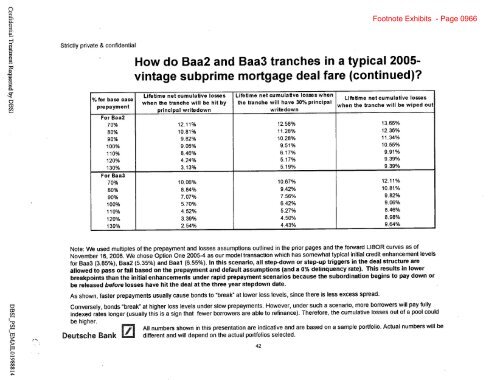2007_Subprime_Shorting-Home-Equity-Mezzanine-Tranches-1
2007_Subprime_Shorting-Home-Equity-Mezzanine-Tranches-1
2007_Subprime_Shorting-Home-Equity-Mezzanine-Tranches-1
Create successful ePaper yourself
Turn your PDF publications into a flip-book with our unique Google optimized e-Paper software.
Footnote Exhibits - Page 0966<br />
Strictly private & confidential<br />
How do Baa2 and Baa3 tranches in a typical 2005-<br />
vintage subprime mortgage deal fare (continued)?<br />
% for base case Lifetime net cumulative losses Lifetime net cumulative losses when Lifetime net cumulative losses<br />
prepaymprincipal rbasment when the tranche will be hit by the tranche will have 30% principal when the tranche will be wiped out<br />
writedown writedown<br />
For Baa2<br />
70% 12.11% 12.58% 13.66%<br />
80% 10.81% 11.28% 12.36%<br />
90% 9.82% 10.28% 11.34%<br />
100% 9.06% 9.51% 10.55%<br />
110% 8.46% 6.17% 9.91%<br />
120% 4.24% 5.17% 9.39%<br />
130% 3.13% 5.19% 9.39%<br />
For Baa3<br />
70% 10.06% 10.67% 12.11%<br />
80% 8.84% 9.42% 10.81%<br />
90% 7.07% 7.56% 9.82%<br />
100% 5.70% 6.42% 9.06%<br />
110% 4.52% 5.27% 8.46%<br />
120% 3.39% 4.50% 8.98%<br />
130% 2.54% 4.43% 9.64%<br />
Note: We used multiples of the prepayment and losses assumptions outlined in the prior pages and the forward LIBOR curves as of<br />
November 16, 2006. We chose Option One 2005-4 as our model transaction which has somewhat typical initial credit enhancement levels<br />
for Baa3 (3.85%), Baa2 (5.35%) and Baal (6.55%). In this scenario, all step-down or step-up triggers in the deal structure are<br />
allowed to pass or fail based on the prepayment and default assumptions (and a 0% delinquency rate). This results in lower<br />
breakpoints than the initial enhancements under rapid prepayment scenarios because the subordination begins to pay down or<br />
be released before losses have hit the deal at the three year stepdown date.<br />
As shown, faster prepayments usually cause bonds to "break" at lower loss levels, since there is less excess spread.<br />
Conversely, bonds "break" at higher loss levels under slow prepayments. However, under such a scenario, more borrowers will pay fully<br />
indexed rates longer (usually this is a sign that fewer borrowers are able to refinance). Therefore, the cumulative losses out of a pool could<br />
be higher.<br />
AII numbers shown in this presentation are indicative and are based on a sample portfolio. Actuanubrwile<br />
Deutsche Bank different and will depend on the actual portfolios selected.<br />
42



